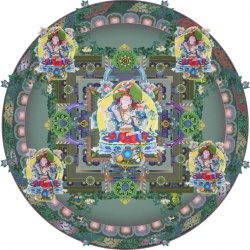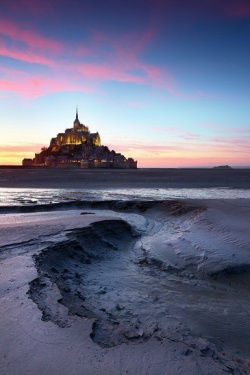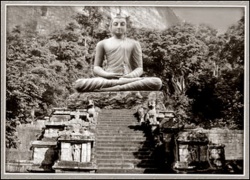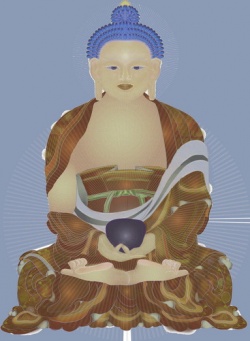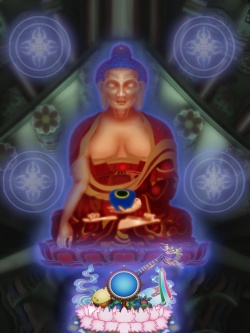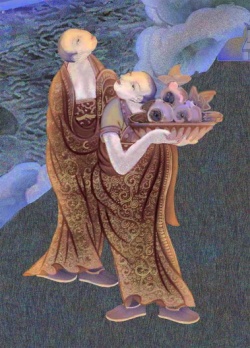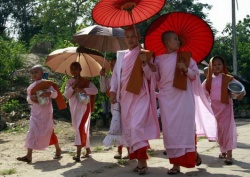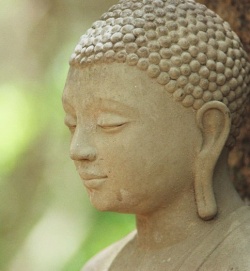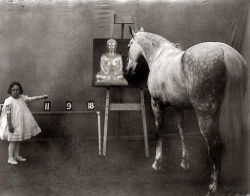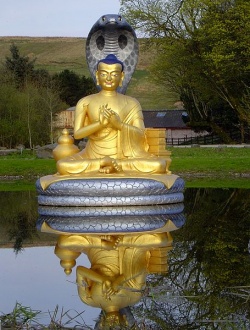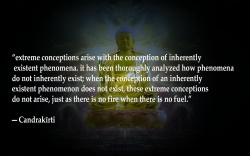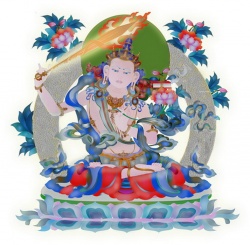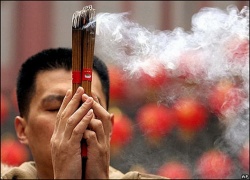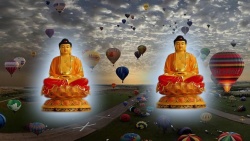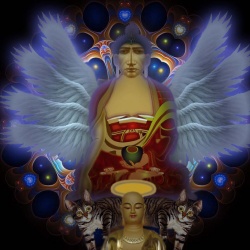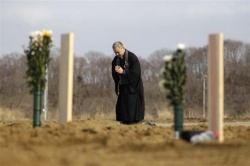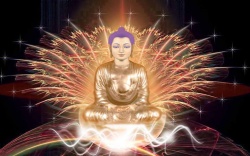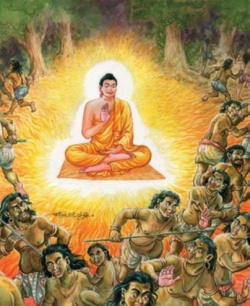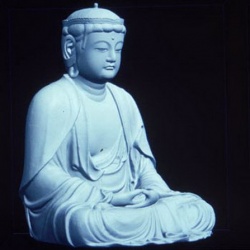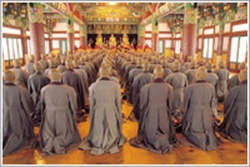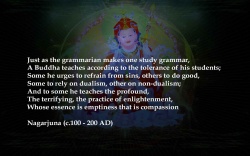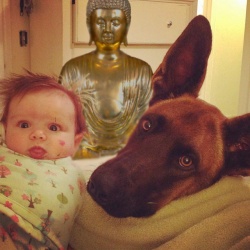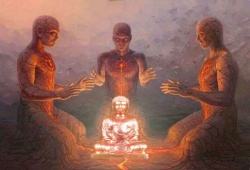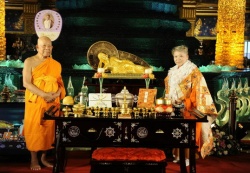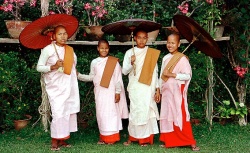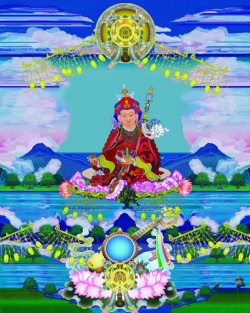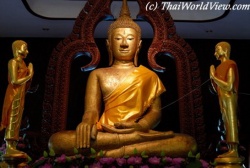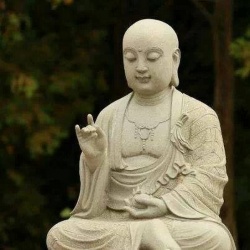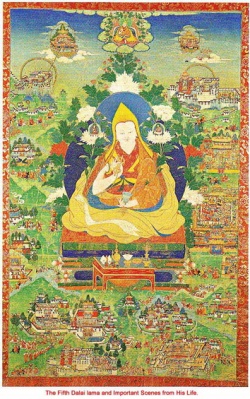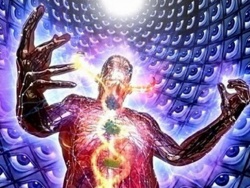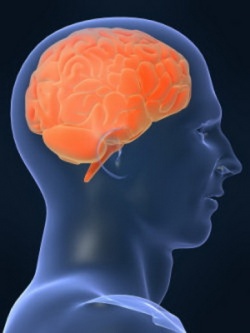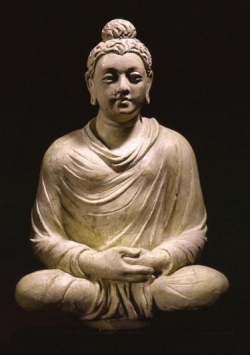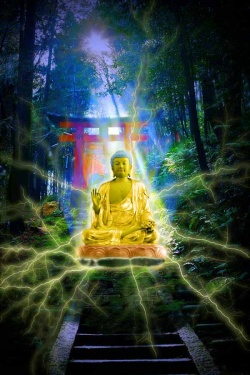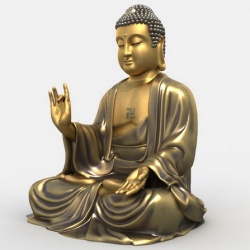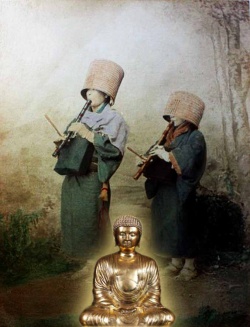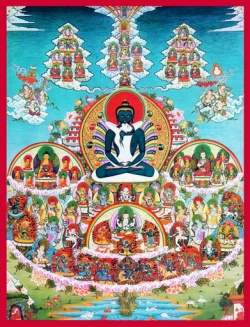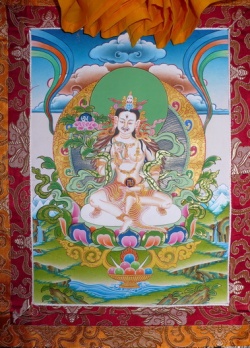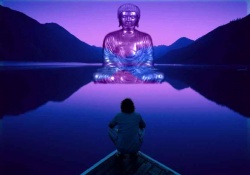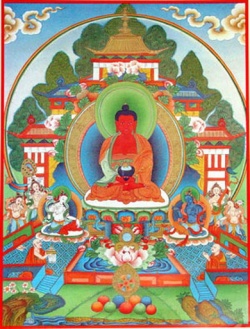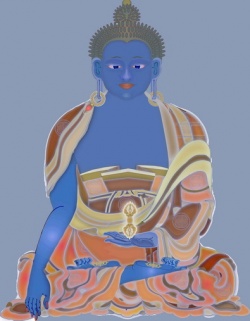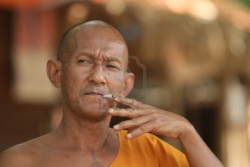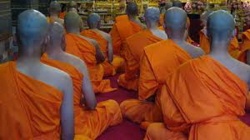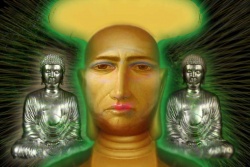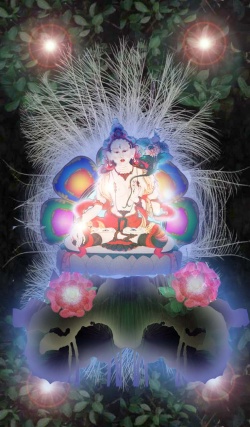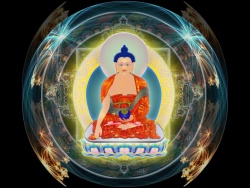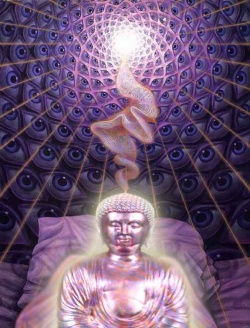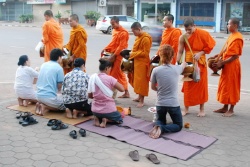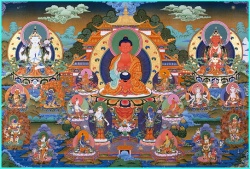Agni
Agni (Sanskrit: Agni), pronounced " ag'ne ", is a Hindu deity, one of the most important of the Vedic gods. He is the god of fire <energy> and the acceptor of sacrifices for onwards conveyance to other deities.
The sacrifices made to Agni go to the deities because Agni is a messenger from and to the other gods.
He is ever-young, because the fire is re-lit every day, and is immortal.
In the Rig Veda (I.95.2), a Rishi prays - for the ten eternal powers to bless Tvashtr (the supreme mind which creates all things) with the birth of Agni which is a reference to the ten undisclosed powers that nourish Agni.
Yaskacharya explains that the fire-god is called (Agni) because he is (Agrani), the forward leader who is the ever awake disseminator of knowledge and the first principle of thought which manifests as Speech; it is carried at the front in all ritualistic undertakings (yajnas).
Pippalada, the sage of the Prashna Upanishad, merely highlights the (the Sole person) status of Agni when he tells Kabandhi Katayana – "
That very one, Surya who is Aditya, rises up who is Prana and Agni, who is identified with all creatures and who is possessed of all fame.
" The Vedic Rishis knew knowledge to be the quality of the Atman. Surya, Aditya, Prana and Agni stand for the Atman who reveals itself as knowledge by the all-illuminating bright rays of light and who reveals itself as objects cognized by the mind and described through speech (Rig Veda X.135.7).
According to the Puranas, the origin of Krittika nakshatra (the Pleiades star-cluster) ruled by Agni, and the birth of Kartikeya is associated with Agni.
The Death-conquering Agni-rahasya vidya, which was received by Prajapati from the self-existent Brahman, is detailed in the tenth kanda of the Shatapatha Brahmana.
During Vedic times, animal sacrifices to propriate Agni were frequently made. Agni is also referred by the name Chagavahana.
In general terms, Agni is regarded, along with earth, water, air, ether, time, directions, atman and mind, as a thing that exists possessing distinct qualities – - Vaise?ika Sutra (I.i.5)
Overview
Agni occupies a prominent place in the Vedas and Brahmanas works.
The ancient Indians recognized Agni as the power of heat and light and the will-power united with wisdom, they knew the human will-power to be a feeble projection of this power which they believed could be strengthened by the Rig Vedic chants to Agni.
The Vedic people developed the worship of Agni, personified and deified Agni as the sacrificial fire, as the priest of the gods and as the god of the priests, who through yajna carries the oblations to the gods, the celestial controllers of the mysterious and potent forces of nature, to ensure the continuance of conditions favourable to mankind.
In Vedic deities, Agni occupies, after Indra, the most important position.
In the Rig Veda there are over 200 hymns addressed to and in praise of Agni.
Agni is the Rishi ('hymn-seer') of Sukta X.124 of the Rig Veda, and along with Indra and Surya makes up the Vedic triad of deities.
Agni, the Vedic god of fire, is depicted as having two heads, one head marks immortality and the other marks an unknown symbol of life.
With Varuna and Indra he is one of the supreme gods in the Rig Veda.
Due to the link between heaven and earth, and between deities and humans, he is associated with Vedic sacrifice, taking offerings to the other world in his fire.
In Hinduism, his vehicle is the ram.
The Aryans (arya meaning 'noble'), who developed the worship of fire, personified and deified the sacrificial fire as God Agni.
Acquired as a gift from heaven, Agni’s birth at three levels – earth, mid-space and heaven, reflects the 'domestic fire', the 'defensive fire' and the 'offering fire' of the Vedic house-holder; the mid-space is the womb, the source of rain-water.
Offended by Agni, Bhrigu had cursed Agni to become the devourer of all things on this earth, but Brahma modified that curse and made Agni the purifier of all things he touched.
Etymology
The word agni is Sanskrit for "fire" (noun), cognate with Latin ignis (the root of English ignite), Russian (ogon), Polish "ogien", Slovenian "ogenj", Serbo-Croatian oganj, and Lithuanian ugnis—all with the meaning "fire", with the reconstructed Proto-Indo-European root being h1égni-. Agni has three forms: 'fire', 'lightning' and the 'Sun'.
Sthaulasthivi informs us that Agni is the drying agent which neither wets nor moistens anything. Sakapuni tells us that the word Agni is derived from three verbs – from 'going',
from 'shining or burning', and from 'leading'; the letter "a" is from root "i" which means 'to go', the letter "g" (??) is from the root "añj" meaning 'to shine' or "dah" meaning 'to burn', and the last letter is by itself the root "ni" (??) which means 'to lead'.
Yaskacharya explains that it is called (Agni) because it is (Agrani), the forward leader who is the ever awake disseminator of knowledge and the first principle of thought which manifests as Speech; it is carried at the front in all ritualistic undertakings (yajnas).
Variants of Agni
In Hindu scriptures, Agni is the God of Fire, and is present in many phases of life such as honouring of a birth (diva lamp), prayers (diva lamp), at weddings (the yajna where the bride and groom circle the fire seven times) and at death (cremation).
In Section VII of the Sabha Parva of Mahabharata, Narada speaks about the twenty-seven fires conveying the sacrificial butter, which fires are:-
Angira (– Angiras, son of Bharata, himself became Agni whom he surpassed when Agni began to practise penance,
Dakshinagni (- consecrated fire taken from the house-hold fire and placed in the south side,
Garhapatya – the perpetual house-hold fire,
Ahavaniya – consecrated fire taken from the house-hold fire and placed in the east side,
Nirmanthya – fire produced by friction,
Vaidyuta – lightening,
Sura – powerful mighty fire,
Samvarta – the fire that destroys,
Laukika – the classical fire, belonging to the world of men,
Jathar – the old or ancient fire, the fire pertaining to the stomach,
Vishagha – the entwining fire,
Havya-vahan – the bearer of oblations,
Kshemavan – the secure, tranquil fire,
Vaishnava – the fire relating to Vishnu,
Dasyuhan – the fire who is the destroyer of the dasyus,
Balad -
Santa – the calm, peaceful, serene fire,
Pushta – the ever-equipped, protected fire,
Vibhavasu – the fire which is one of the eight vasus
Jotishmata – the luminous, pure, brilliant fire,
Bharat – the fire who is the priest, maintained,
Bhadra – the great, auspicious fire,
Swistikrt – the fire causing welfare or prosperity,
Vasumaya – the fire consisting of wealth or of good things
Ritu – the fire of light, splendor,
Soma – the fire which is nector, ethereal,
Pitryana – the conveyor of virtuous persons to heaven.
There are five kinds of Agni (fire) –
Kala-agni ('the fire of time'),
Ksudha-agni ('the fire of hunger'),
Sita-agni ('the cold fire'),
Kopa-agni ('the fire of anger') and
Jñana-agni ('the fire of knowledge').
Agni is also the name of one of the Saptarishi of the Svarocisa Manvantara, one of the Saptarishi of the Tamasa Manvantara and one of the Saptarishi of the Indrasavarni Manvantara which is yet to come.
Agni is the name of the son of Dharma and Vasordhara, of an Acharya and of a disciple of Indra.
Vedic conception of Agni
Agni is the first word of the first hymn of the Rig Veda (Sukta I.i.1) revealed to Rishi Madhuchchandah Vaishvamitah in Gayatri metre, which reads:
With this mantra the Rig Veda begins with a prayer to Agni, the receiver, holder and distributor of energy, who leads the devas to victory in their battles against the asuras, and confers wealth of various kinds to the performers of yajnas.
The first line of the first mantra of the first sukta of the first mandala of the Rig Veda consists of six words.
The first word is agnimeeley, which is a compound word of eight sound syllables.
This word is made of two words agni (energy) and eeley (initiate or pray). The Vedic mantras were the direct perceptions of the seers - .
The purport of the afore-cited important mantra (Rig Veda I.i.1) is:
"I aspire intensely for Agni, the adorable, the leader who carries out the yajna; who does and gets done the yajna in due season, who is the summoning priest capable of bringing the gods to the yajna performed here, and the one who establishes excellent felicities in the aspirants. "
Agni is the 'Mystic Fire', adored by the ancient and the present seers, to whom obeisance is carried by thought, and who endowing inner plenitude to the performers of yajnas, leads the yajna and through seer-will, and as the summoning priest takes them forward on the journey leading to God who is Truth.
Agni is the envoy, the carrier of offerings, who born in the human aspirant, awakens the gods, burns the opposing foes - the demons.
Agni, the youthful lord of the house who has the flame-tongue for his mouth, is invoked (kindled) by Agni –
who is the destroyer of afflictions, the purifier possessing the power that fills and fulfils.
Agni is the supreme director of religious ceremonies and duties, and figures as messenger between mortals and gods. Vedic rituals all involve Agni, for example, the elaborate Agnicayana , which is the piling of the fire-altar usually in the shape of a shyena, and the Agnihotra , which is making offerings to Agni.
The Rig Veda often says that Agni arises from water or dwells in the waters; the Vedic sage says that Agni manifesting in the waters and seated in the lap of the winding waters, flaming upward, increases; and that Agni was born by the prowess of Tvashtr (Rig Veda I.95.5).
He may have originally been the same as Apam Napat, the supreme god of creation, who is also sometimes described as fire arising from water. Hydrogen burns easily and Oxygen is required to inflame the fire.
This is the important physiological phenomenon in any living body, which in a natural explanation may have referred to flames from natural gas or oil see pages surfacing through water, or as the seven rays or seven bands of light of a rainbow.
Other Rig-vedic names, epithets or aspects of Agni include Matarishvan, Jatavedas, or Bharata.
Sayana holds the term Vishva-Vedah appearing in the Taittiriya Samhita (IV.iii.2.10) – to mean - Dawn, but in the Rig Veda :-
this term refers to Indra, the Protector, and to the all-knowing Agni.
Agni is a deva , second only to Indra in the power and importance attributed to him in Vedic mythology, with 218 out of 1,028 hymns of the Rigveda dedicated to him. He is Indra's twin, and therefore a son of Dyaus Pita and Prthivi.
However, he is also said to have two mothers, or has two parts of the firedrill used to start the fire, and ten servant maids (the fingers of the man who is lighting the fire or the ten undisclosed powers that nourish Agni) or as the 'twice-born'.
He is one of the Guardians of the directions, representing the southeast. Rishi Medhatithi Kanva of the Rig Veda (I.xiii.3) calls Agni meaning the sweet-tongued.
In the Mundaka Upanishad (I.ii.1-5) it is said that Agni, here meant the Ahavaniya Fire, has seven tongues or flames – Kali ('black'), Karali ('terrible'), Manojava ('speedy as the mind'),
Sulohita ('very red'), Sudhumravarna ('coloured like thick smoke'), Sphulingini ('emitting sparks') and Vishwaruchi ('having the fuel as the Sun' (II.i.5)).
Agni, who is addressed as Atithi ('guest'), is also called meaning - the one who knows all things that are born, created or produced (Rig Veda I.xliv.4), thus Rishi Praskanva states that Agni represents great learning and enlightening wisdom which ought to be sought, located and humbly approached.
Agni excites Buddhi (reason and intellect), the perceiving and the determining factor, and by illuminating the mind it makes one understand and comprehend the truth (Rig Veda I.xliv.7).
The Rishis of the Rig Veda knew knowledge to be the quality of the Atman, which quality inheres in the Atman and is in the nature of manifestations as physical and mental objects that exist in Time and Space.
Therefore, by invoking Agni, the self-sustaining child who generates his mothers (two mothers) by his own powers - (Rig Veda I.95.4), and as the guardian of all existence is also invoked the Unseeable One and His invisible power of infinite strength and magnitude which supports, sustains and protects space and all things, including Fire and Time, contained in Space.
The Vedic Rishis, who knew that the mind sees, hears, etc., when it is illumined by the light of consciousness and that – (Brahma Sutras (III.ii.15) like light, Brahman can be assumed to have different appearances, held Agni to be responsible for the manifestation of gods for the mortal beings who then come to know them and worship them by the mind –
(Rig Veda (I.77.2), and pray – (Rig Veda (I.79.11) for Agni, which is the essence of the knowledge of existence, to increase its own strength or power that is within all human beings to enable them to cultivate strong conviction and belief without which there cannot develop a meaningful faith and deep devotion to support a dedicated mind.
Agni, identified with energy and action, is the first emanation and the sacred spark hidden within all beings, he hid from the gods but Atharvan found him.
Atharvan first churned out Agni whom he gathered with four mantras and four metres as the four metres (Taittiriya Samhita V.i.4); in other words, Atharvan with the aid of Agni had found Agni and raised Agni, thus combining the divine and the human worlds transforming the sublime and the subtle to the gross and the material.
Agni denotes the natural element fire, the supernatural deity symbolized by fire and the inner natural will aspiring for the highest knowledge.
Heat, combustion and energy is the realm of Agni which symbolizes the transformation of the gross to the subtle; Agni is the life-giving energy.
Agnibija is the consciousness of tapas (proto-cosmic energy), agni (the energizing principle) and the sun, representing the Reality (Brahman) and the Truth (Satya) is Rta, the order, the organizing principle, perceived by the constant rhythm of renewed equilibriums and the constant search for the essence underlying what is and what is not.
Rishi Praskanvah Kanvah states (Rig Veda I.44.10) – that Agni which is rich in lustre has blazed after many proceeding dawns; here, dawn refers to the vision of truth and to the spiritual experience which has a natural end.
Rishi Nodha Gautama prays (Rig Veda I.60.5) – for Agni, rich in thought, to come soon at dawn; here, dawn refers to actual sunrise and also to spiritual experience or awakening. Agni is also called the lover of dawn:-
and asked to fill the two (Heaven and Earth) with light (of knowledge) like the Sun.
Vedarambha (the beginning of the Vedic study) in earlier days usually coincided with the Vratadesa (the Upanayana ceremony) conducted on an auspicious day and began with the sacred Gayatri mantra followed by Matrpuja, Abhyudayika Sraddha as part of preliminary ceremonies where after having established the Laukika-Agni the teacher made the student sit on the Western side of the fire, declaring Agni to be the teacher placed the student to Agni’s care.
And two ahutis of ghee were offered to the earth and Agni in case of Rig Veda; to Antariksa and Vayu in case of Yajur Veda; to Dyau and the sun in case of Samaveda and to the quarters and the moon in case of Atharvaveda beginning.
On completion of studies and after observing the prescribed brahmacharya and becoming Vidyasnataka and Vratasnataka, the student career ended with most pupils opting for the normal life of the world but a few preferred the life of detachment From the Chandogya Upanishad it is learnt that Upakosala had in the ashrama of Satyakama Jabala tended, through Agni-yojana (causing of the sacrificial fire to blaze up) and Agni-rakshana (preservation of the sacred fire), the fires of his teacher for many years.
His teacher delayed imparting the desired knowledge; but the fires he tended, pleased that he had performed his tapas and tended the fires well, mutually enkindling his mind reciprocated and revealed to Upakosala the true nature of Brahman.
Agni and Rudra
In the Rig Veda, Agni is addressed as Rudra, in which event, according to Satarudriya (oblation) section of the Yajurveda, there comes about in a singular depiction two distinct but destructive aspects of nature - 'storm' and 'fire'. In a prayer (R.V.I.27.10) addressed to Agni, the sage prays addressing Agni as having the fierce nature of Rudra, the one who makes the evil persons weep. Yet another sage praying (R.V.II.i.6) –
Rishi Gutsamada (R.V.II.33.9) calls Agni the fierce-tempered Rudra, the tormentor of the evil-minded evil-doers, the one who makes everyone weep; he even calls Rudra the lion whose roar is ferocious.
Sayana explains that Rudra having the nature of Agni had carried off the treasures thrown away by the gods. Prajapati calls Agni, Rudra because Agni had made him cry. The Shatapatha Brahmana (VI.i.3.7-10) tells us that Rudra is the first of the eight names of Agni – "Rudra is indeed Agni".
The same text also states (IX.i.1.1.) that – "This all – pervading subtle fire is the very god Rudra". This text provides details of Agni's threefold state i.e Rudra, Sarva, Pasupati, Ugra, Asani, Bhava, Mahan Devah, Isana, Kumara.
A sage of the Rig Veda (R.V.VI.49.10) calls Rudra the Isana of the world, "the Father of the World" who has multiple forms (R.V.II.33.9).
The Taittiriya Samhita (IV.2.10) mentions multiple forms of Agni almost similar to Rudra; the same text tells us that Rudra is Agni’s fearful body, to mean Rudra is an aspect of Agni.
With the piling-up of the fire-altar, Rudra becomes Agni. The multi-valancy of "five" in the Agnicayana, representing the five-headed five-limbed entity extending beyond all phenomenal dimensions, is connected and identified with Rudra, and with Agni in its Rudra-form.
The Linga Purana tells us that a pillar of fire (stambha), of the fire that seemed to be burning without any fuel endless and infinite, appeared before Brahma and Vishnu; from it had burst-forth the self-assured five-headed Shiva smeared with ash and wrapped in animal skins, who pronounced that Brahma was not a god because he lies to delude the world, and that Vishnu was in the process of becoming a god because he was as yet curious to know what lies beyond the horizon. The Shiva-linga represents that pillar of fire which is Agni.
Agni, Vayu and Soma
In the Vedas, Agni, Vayu and Soma or 'fire' (light and heat), 'air' (energy and action) and 'water', which are three of the five tanmatras born from the three heated worlds, are the principal deities;
Agni brings the subject and the object together and establishes a relation between the two (sambandha); Vayu causes that relation to evolve (abhidheya), and whose activity Soma directs converting forms into pleasure that consciousness enjoys (prayojna). These three shaktis are involved in all material and spiritual vedic rituals.
Agni, Vayu and Jala are three of the three-fold eight fundamental qualities of intelligence i.e. eight in terms of the value of consciousness, eight in terms of the devata quality of consciousness and eight in terms of the chhandas quality of consciousness.
Rishi Nodha Gautama informs us (Rig Veda I.60.1) that agni was brought by Matarishvan to Bhrigu as a gift; matarishvan refers to the one who breathes life in the mid-world (life-breath or prana or vayu), matari is an epithet for God Vayu. And elsewhere, Rishi Hiranyastupah Angirasa prays (Rig Veda I.31.3)
" You Agni are important for Vayu " simply because for the manifestation of agni, and it is also necessary for vayu, the pervading life-force, to stir agni which is (latent in human beings) into action in all the spheres (Rig Veda I.71.4).
Matarishvan refers to agni (tejas) and vayu (prana), both (Nirukta VII.26).
Agni is described as dwelling in waters (apah) which cleanse moral guilt, sins of violence, cursing and lying, and purify the worshippers.
Apam Napat is besought to give waters rich in honey for increased strength. Agni is also described to have its origin in aerial waters.
A Yajurveda mantra -
refers to Agni-Jala vidya essential to the mastering of the Agni-vidya, for water is used to purify the yajna and also all those involved in the performance of the yajna; water in its own turn is purified by the wind (vayu) which lifts the yajna-fumes upwards from the yajna which then induces rain and thus ensuring prosperity and righteous growth, enhances wisdom.
Agni, which consumes all oblations offered to it, is also called Arka which is 'Water', the accessory to worship and the cause of fire that covers all food which covers all life for life feeds on life (Yajurveda V.vii.5).
Rishi Tritapti (Rig Veda X.v.3) in a mantra in praise of Agni refers to the bearers of water, the most subtle and the most refined aspects of manifestations, and in a subsequent mantra, Rig Veda X.v.7, he says that in the conditions prevalent prior to formation of water,
Agni, which originated from the subtlest of the subtle manifestations as the first visible manifestation of the Unmanifested, was the giver and the taker, both, because as energy it had transformed into matter beginning with water.
Agni and the Animal Sacrifice (pasubandha)
During Vedic times, animal sacrifices to propriate Agni were frequently made; Agni is the deity of primary invocation and the deity that represents all other deities.
Pasuyajña had many forms and the animal to be sacrificed was tied to an octoganal wooden stake called yupa, be it a he-goat, a horse or a bull.
In the asvamedha animals were offered to Soma and Prajapati.
Pasubandha is included in the group of seven sacrifices of the havis. The entire ceremony was supervised and co-ordinated by an adhvaryu because this ritual called for the completeness of the sacrifice to meet the demands of the liturgical rules.
Niruddha-pasubandhayajna involving immolation of a he-goat was an obligatory rite performed once in six months or once a year with the aid of six priests to appease Indra and Agni with Surya and Prajapati as deities.
The Rig Veda does not make a direct reference to animal sacrifice; the hymns make no mention of actual sacrifice of an animal which is merely referred to as an oblation.
In the following Rig Veda mantra (R.V.VIII.43.11) addressed to Agni,
Rishi Virupa Angirasa invites all devout to pray to the Supreme lord who is the bestower of benefits , who is the caretaker and protector of all reated things, and here represented by Agni.
Agni is called ukshanna and vasanna, that is, the eater of bulls (uksha) and barren cows (vasa); during those times the slaying of a barren cow was an essential feature of funeral ceremonies.
The Shatapatha Brahmana (VI.ii.1.2-3) speaks about the five animals or sacrificial victims viz., man, bull, horse, ram and he-goat, which Agni enters and becomes.
The same text explains that it is Agni who is sacrificed as animal victim (SB XIII.ii.7.13), the goat is the animal form of Agni (SB VII.v.2.36).
Since Prajapati, the finite form of the Purusha, is one with Agni and the Fire-altar (SB VI.i.1.5) and the animal nature burnt the sacrifices and the prayers ascend to reach the highest levels or summit.
The Aitareya Brahmana speaks about the fire carried around the animal which is to be sacrificed thrice reciting the prescribed three mantras. And, Apri mantras are recited which are verses of invitation.
The offering of the goat to Agni is the nature of all animal sacrifices (pasubandha) performed by man who establishes the fire before he eats meat. The animal is tied to a post till the time it is sacrificed on the second day of the rites; not more than eleven animals were sacrificed on one occasion.
Nature and significance of Agni
Atharvan, the first teacher of divine wisdom (Brahma-vidya), was the eldest son of Brahma; as a priest he first instituted worship of 'fire' (Agni) and 'nectar' (Soma).
According to Agni Purana, which is the eighth in the list of eighteen Puranas, no god is approachable without the medium of Agni, and no divinity is without the presence of Agni; his element is earth.
At the command of Bhrigu, Agni was brought down from the heavens for man’s use by Matarishvan, in the later writings Agni is described as a son of Angiras who happened to discover fire and its uses.
Agni as the immortal guest is the witness of all actions, supremely powerful, all consuming and unresistible but who commands all earthly and heavenly riches i.e. all temporal good.
His most destructive aspect is when he acts as Kravyad.
Agni first appeared in the heavens in the form of lightening; this was his first birth, his second birth was among the human beings as Jataveda (learned by birth); his third birth was in water (Rig Veda I.45.1).
Agni has two forms: Jataveda and Kravyada.
Jataveda is invoked to burn and carry the offerings (except flesh) to the respective Gods, in which case Agni is light identified with knowledge and with Brahman.
Kravyad is invoked to burn the flesh (corpses and animal parts) in the Pitri-yajna for which purpose Agni is obtained from the rays of the Sun.
In the Jataveda form, Agni, the god of fire, acts as the divine model for the sacrificial priest.
He is the messenger who carries the oblation from humans to the gods, bringing the Gods to sacrifice, and interceding between gods and humans (Rig Veda I.26.3).
When Agni is pleased, the gods are generous. Agni represents the cultivated, cooked and cultured aspects of Vedic ritual. Together with Soma, Agni is invoked in the Rig Veda more than any other gods.
The Rishis of the Rig Veda held Agni to be responsible for the manifestation of gods for the mortal being who then comes to know them and worship them by the mind therefore, they pray to Agni to increase its own strength or power that is within all human beings for them to cultivate strong conviction and firm belief (shraddha) without which there cannot develop a meaningful faith and deep devotion to support a dedicated mind.
Agni is the essence of the knowledge of Existence, with its increase is wholly destroyed ignorance and all delusions, there is no nescience to be taken for granted and the human form assumed by Brahman is erased from the mind.
Shraddha is that which supports and upholds Truth; it indicates a state of harmony.
Shatapatha Brahmana (SB 6.1.1.1) tells us that Prajapati was generated through the tapas of the rishis (equated with the non-existent of the Beginning), thereafter, through his own tapas Prajapati generated all the gods and all the creatures.
He also generated Agni as the sacrificial fire and as the second self having wearied himself his glow and essence of him heated up and developed Agni (SB 10.6.5.2). Ritually Agni, as the altar built by the sacrifice, reconstitutes Prajapati.
Kravyad is the form of Agni which eats corpses, the fire of the funeral pyre; the fire that eats corpses can eat everything.
This is the impure form which is much feared. In this form, after one’s death and at the time of cremation, Agni heats up and burns the body only, the body which is the impure human condition (SB 2.2.4.8).
In the Rig Veda (I.95.2), a Rishi prays for the ten eternal powers to bless Tvashtr (the supreme mind which creates all things) with the birth of Agni, which is a reference to the ten undisclosed powers that nourish Agni.
Yaskacharya explains that it is called (Agni) because it is (Agrani), the forward leader who is the ever awake disseminator of knowledge and the first principle of thought which manifests as Speech; it is carried at the front in all ritualistic undertakings (yajnas).
Pippalada, the sage of the Prashna Upanishad, merely highlights the (the Sole person) status of Agni when he tells Kabandhi Katayana "
That very one, Surya who is Aditya, rises up who is Prana and Agni, who is identified with all creatures and who is possessed of all fame."
The Vedic Rishis knew knowledge to be the quality of the Atman.
Surya, Aditya, Prana and Agni stand for the Atman who reveals itself as knowledge by the all-illuminating bright rays of light and who reveals itself as objects cognized by the mind and described through speech (Rig Veda X.135.7).
The Kanvasatpathabrahmanam (SB.IV.i.iv.11) calls Agni - 'Wisdom' and the 'Mind' Rishi Bharadavaja Barhaspatya in a mantra addressed to Agni Vaishvanara (Rig Veda VI.ix.5) calls Agni - the mind swiftest among (all) those that fly.
In his commentary on Rig Veda sukta I.77, Sri Aurobindo explains that Agni is the Will in Prana, the dynamic life-energy.
Agni devours, enjoys, purifies, prepares and assimilates to rise upwards always as it transfigures its powers into Maruts, the energies of Mind.
And, Agni as the Will in the mind clarifies/purifies the mind by aspirations, enters into the intellect and leads the thoughts and active energies towards light.
He also explains that the Vedic gods represent the highest powers of the human mind – Indra signifies the illumined mind and therefore, the highest of the three heavens, the three realms of the Universal Mind (Rig Veda I.xxxv.6), and Agni signifies the will and aspirations.
In Satyarth Prakash, it is explained that the first sound "a" of "aum" stands for Virat, Agni and Visva; and the word Agni is derived from the root añcu which means - 'to move', 'to worship'. Therefore, the word Agni means the one who is worthy of worshipping, knowing and seeking. Pa?ini refers to the practice of worshipping Agni each time by two mantras of Vihavya (hymn) i.e. of the Rig veda (X.128). In the Yoga philosophy of Patanjali's, Agni is treated as an element -
"Of these, Akasa, Vayu, Agni, Udaka and Bhumi are the Bhutas "
the elements, the diversified varieties of the undiversified tanmatras) connected with the Sparsa-tanmatra ('thermal monad') and the Rupa-tanmatra ('light monad').
Depictions of Agni
In Hindu scriptures, Agni is depicted with two or seven hands, two heads and three legs.
He has seven fiery tongues with which he licks the sacrificial butter.
He rides a ram or a chariot harnessed by fiery horses.
Agni is represented as red and two-faced, suggesting both his destructive and beneficent qualities, and with black eyes and hair, three legs and seven arms.
He rides a ram, or a chariot pulled by goats or, more rarely, parrots.
Seven rays of light emanate from his body.
One of his names is Saptajihva, "the one having seven tongues".
Another one of his epithets is Abhimani (from Sanskrit: abhi (towards) + man (the verbal root man 'to think', 'reflect upon') meaning dignified, proud; longing for, thinking.
Agni is worshipped as the symbol of piety and purity; as expression of two kinds of energy i.e. light and heat, he is the symbol of life and activity.
When Agni is worshipped all gods (gods are symbols of life) lend their powers to this deity.
The ancient seers had divided Agni into three parts – garhapatya (for general domestic usage), ahavaniya (for inviting and welcoming a personage or deity) and dakshinagni (for fighting against all evil).
Agni is the chief terrestrial deity personified by the sacrificial fire which is the centre of the ritual poetry of the Rig Veda.
The earth enveloped in darkness and the sky, become visible when Agni is born; the acquisition of fire by man is regarded as a gift of the gods. Agni is only compared and not identified with the Sun.
Yaska states that his predecessor Sakapuni regarded the threefold existence of Agni as being in earth, air and heaven as stated by the Rig Veda but a Brahmana considered the third manifestation to be the Sun.
Agni, who is more closely connected with human life than any other god, is often identified with other gods, especially with Varuna and Mitra, in the evening he becomes Varuna, when he rises in the morning he becomes Mitra.
And, his priesthood is the most salient feature of his character.
A sage of the Rig Veda (Sukta IV.iii.11) states that the Sun became visible when Agni was born.
In the collection at Bharat Kala Kendra (Benares Hindu University), there is a First century CE, red sandstone sculpture identifiable as Agni shown in the garb of a Brahmin, very much like sage Kashyapa, on the Govindanagar Rsyasrnga door-jamb.
In the Panchala coins of Agnimitra there is deity with a halo of flames and on Kushana coins there is engraved an Iranian deity under the name of Athos (Agni?); in Gupta sculptures, Agni is shown as a Brahmanical deity with a halo of flames round the body and also with a beard, pot-bellied and holding amrtaghata (nectar-pot) in his right hand.
Agnihotra yajna
Agnihotra means - 'sacrificial fire'; the Agnihotris once maintained a perpetual fire in their homes.
This ritual ceremony was conducted on important and auspicious occasions; in many homes prayers are still offered to Agni (fire).
The sage of the Atharvaveda (Sukta 19.55.3) prays to the fire for happiness and peace, for a happy temperament, resolve and good health, for strength and mental contentment, and as the ladder to spirituality.
The sage also states that Agnihotra destroys enemies (Atharvaveda 9.2.6).
Even Gautama Buddha had explained the importance of the yajna of Agnihotra as "the ocean amongst rivers, a king amongst people and Savitri amongst the verses" (Sutta Nipata 568/21).
Indian people consider it as the duty of the man who has established his fires, as of the man who has no fires, to daily, morning and evening, to perform Agnihotra.
If the fires are kept perpetually alight, then they are required only to be brightened up for each occasion, if otherwise then it has to be taken from the garahpatya.
The main offering is milk, and at the end, the sacrificer offers four water oblations i.e. to the gods, to father and the fathers, to the seven seers and to Agni on earth.
Shatapatha Brahmana (SB 3.1.3.18) tells us that Agnihotra should be performed by the performer knowing that he will gain the strength and victories gained by Agni who conquered the earth, Vayu, the air and Surya, the sky, with whom he shares the world; and the same text further tells us that the Agnihotra, doubtless, is the Sun.
Prajapati had to create milk as food for the hungry Agni and perform the first act of Agnihotra to avoid death and preserve his own existence.
Agnihotra is believed to free the yajmana (the performer of the yajna) from evil and death, both signified by Agni.
The priest invokes Agni through Agni in his sacrificial form; the sacrificial form of Agni is the Sun which shining brightly appears to all men.
The priest also invokes Vayu which is Agni’s own greatness.
Therefore, Agni as the deity is treated differently from Agni, the messenger who carries oblations to the gods. The sacrificial form of Agni is Aditya and Vayu.
Shankara in his commentary on the Brahma Sutras states that the rightful observance of the agnihotra and other rites are meant for those desirous of attaining Heaven and other enjoyments, and the understanding of the rightful doctrine of the Soul is meant for those desirous of emancipation.
Upanishadic conception
For the Vedic people Agni was the multifaceted psychological power connected with will, action and related powers, Isha Upanishad focuses on this tradition of Agni as the Divine Will which motivates and executes.
The sage of this Upanishad, offering total submission and self-surrender of all the faculties of the lower egoistic human nature, prays to Agni,
the Cosmic energy on account of which is the universe, and therefore, is the knower of all things that are manifested, to guide and lead him to its own place of origin, to That (Brahman) in which all this is established, to That from which all this has sprung, to
That in which all this finally find refuge (Isha Upanishad.18).
In the Kena Upanishad, Agni reveals his identity as the heat energy and the ever-burning flame of the conscious force in matter that makes up the entire world.
The gods sent first Agni to find out the nature of Brahman, which means it is Agni that releases the energy which is latent in all beings.
Moreover, the sage of the Kena Upanishad refers to the functional differentiation and specialization of body parts on which account the life-stream progresses when he speaks of Agni becoming the speech and entering the mouth and Vayu becoming breath and entering the nostrils.
Pravahana Jaivali, who was well-versed in udgitha, held that the Universe exhibits at every stage the principle of sacrifice in as much as the heaven by itself is a great altar in which the sun is burning as fuel from the oblation that is offered in this sacrifice,
namely shraddha, rises the Moon; looking at the sky again it is seen that parjanya is the great altar in which the year is burning as fuel from the oblation offered in this sacrifice,
namely the Moon, rises Rain; then again the whole world is a great altar in which the earth burns as fuel from the oblation offered in this sacrifice,
namely Rain, rises Food; man himself is a great altar in which the opened mouth is the fuel from the oblation offered in his sacrifice, namely Food, rises Seed; and finally woman herself is a great altar in which Seed being offered as an oblation, rises Man.
This is his celebrated "Doctrine of the Five Fires" - the Panchagni vidya.
Before Satyakama Jabala, in bodily form arose the Three Sacrificial Fires to instruct him, the three fires were –
i) the Garhapatya who told him that the ultimate reality was to be found in the sun,
ii) the Anvaharyapachana who told him that it was to be found in the moon, and
iii) the Ahavaniya who told him that it was to be found in the lightening,
but to whom Upakosala explained that the ultimate reality was to be found not in these three but in the image of the person reflected in the human eye.
And from Katha Upanishad becomes known about Yama taught Nachiketa the secrets of the fire that leads to heaven and what bricks were required to build the altar.
The Chandogya Upanishad conceives the whole universal activity of creation as a kind of yajna (sacrifice) where everything is connected; this sacrifice/knowledge is known as the Panchagni vidya.
The activity of creation (or of manifestation of any object) begins with the birth of the child (or with the production of an atom or molecule) whom the cosmos produces and not parents alone, then the child’s presence is felt everywhere mainly because the universe is intimately inter-connected.
The Shatras teach that the macrocosm is in the microcosm; each manifestation is the quintessence of every particle of Prakrti, and that Prakrti on its own accord takes care of each manifestation or birth and withdraws those manifestations as a part of the operation of the universal laws.
This is the philosophical background of this vidya which deals all events of manifestation not merely as the birth of a human child alone, and which vidya is the contemplation of the mind in perceiving the reality that is transcendent to the visible parts of the inner sacrifice.
The subtle effects (all effects are only phenomenal) produced by all our actions are invisible to the eye, they are called apurva; we, as the causer of apurva, reap the fruits of all our actions; because higher realms are activated by our actions, with every stage of development being a sacrifice i.e. a meditation, the consequence of those actions become the cause of our descent.
The Chandogya Upanishad epitomizes 'Mind' and 'Akasa' into 'Speech', 'Prana', 'Sight' and 'Hearing' into 'Agni', 'Vayu', 'Aditya' and the 'Directions',
and declares that Speech is a foot of Brahman; it shines with Agni as light.
Dhira Satparaneya had told Mahasala Jabala that Agni is Speech (Shatapatha Brahmana X.ii.3).
Agni, precincts and the path of Jnana
Amongst the eleven positive substances listed by Kumarila Bhatta, 'earth' and 'water' are the only two corporeal substances whereas fire is corporeal and incorporeal, both.
From the Kena Upanishad it becomes known that amongst the gods, Agni, representing Brahman on the material plane and being conscious of its source and true identity as the conscious force in Matter, was the first to arise to discover its nature, limits and identity.
The Vedic gods manifest themselves in man and assume the appearance of human limitations.
'Knowledge', 'faith' and 'works', these three, because of their connection with human faculties, are not without their respective limitations, and it is the mortal body harbouring within it the individual self and the Universal Self that remains bound by limitations.
Agni symbolises the soul; it is the power of change that cannot be limited or overcome. Light, heat, colour and energy are merely its outer attributes; inwardly, agni impels consciousness, perception and discernment.
The "a" of the word, agni, refers to the openness from which utterances arise; when any person utters this vowel sound he opens his mouth and also expels breath; this is the beginning and the infinite; agni emits light and is Speech, it causes space for its play to open out.
The "g" of agni is a consonant and refers to an act of formation for making sounds identifiable thereby activating languages;
it is the initial limitation involving the identification of the process of activation as also the nature of the impetus, both related to worldly existence.
Raja Rishi Chitra describing the path of Jnana states:-
" He (at the time of death), having reached the path of the gods, comes to the world of agni, to the world of vayu, ……." - (Kaushitaki Upanishad I.3)
and leads to the Brahmaloka, the Vedic concept of paradise; this is the path taken by the enlightened souls with transcendental knowledge, and this is the Paryanka Vidya which vidya does not reflect on any limitation of agni but lays stress on the varied and graded experience which is in store for the journeying soul.
"according as a man’s works are, so does he become ( is born)", this principle gives the Upanishadic eschatology a great philosophical value; it is in the Kaushitaki Upanishad (I.2) that the law of Karma is plainly spelt out, and it is this particular upanishad which while describing Devayana, the path of the gods, substitutes the unmeaning conceptions of the two major Upanishads - the Brihadaranyaka Upanishad and the Chandogya Upanishad, also dealing with this path, and then talks about attaining eternal life –
- "being free from good and free from evil, knowing Brahman, he (enlightened one) moves towards Brahman" (I.4).
Agni-rahasya
The Tenth Book of the Shatapatha Brahmana (X:1:2:3) which tells us that the Fire-altar is the mind and that the mind is prior to breath (Prana) and speech (Vac) is related by Yajnavalkya in the Chapter V of the Brihadaranyaka Upanishad, deals with Agni-rahasya or the 'mystical teaching of Agni' proclaimed by sage Sa??ilya, and also describes the benefits of the Vajapeya and the Rajasuya sacrifices besides the identification of the person residing in the sun with the person residing in the right eye and the meditation on Brahman as the Mind ("mind is to be meditated upon as Brahman") (Chandogya Upanishad III.xviii.1).
The sages speak about the thirty-six thousand mano-vrittis or 'mental modes', one for each day of life spanning one hundred years, correlated to the mind-generated bricks of the altar on which the fire is lighted up by the mind itself, thus establishing mental connection to the prescribed Vedic ritual acts or rites.
Shatapatha Brahmana (X.5.3.3) speaks about the mind desiring to manifest and having manifest beholding the thirty-six thousand Arka-fires of its own self, the immaterial forms of sacrificial fires or fire-altars (SB X.3.4.3) calculated as the number of days in the life of a perfect man living for one hundred years (SB X.2.6.9).
The Aitareya Brahmana (II.2.4.4) compares in the same manner the thirty-six thousand syllables of one thousand Brihati mantras with the number of days in one hundred years.
The terrestrial world, the air, the sky, the sun etc., are spoken of as the Fire-altars with all things on and in them as various bricks making up the whole Agni.
The Shatapatha Brahmana (IX.v.2.15) and the Aitareya Brahmana (IV.27, VII.34) speak of Tura Kavasheya, the teacher of the Agni-rahasya doctrine, who built a fire-altar to the gods at Karoti and was the purohit of Janamejaya, son of Parikshit, to whom the Mahabharata was recited.
Tura Kavasheya had received this knowledge from Prajapati who had in his own turn received it from the self-existent Brahman which knowledge finally teaches that the Ashvamedha is the yonder shining sun which is Agni which is Brahman and the year is his body, that Agni is Arka and the worlds are his bodies; that both Arka and Ashvamedha combine to become one deity – Death, knowing this one conquers Death (SB X.vi.5.8-9).
Badarayana (Brahma Sutras III.iii.44) and Jaimini (Jaimini Sutras III.iii.14), both agree that the fires of the mind, speech, etc., of Agni-rahasya are not parts of any rite though the Brahmana tells us that " the mind saw itself as thirty-six thousand; it saw the adorable fires as belonging to itself, lighted up by the mind,
and conceived as identical with the mental modes " etc., it is explained that such statements are meant for the glorification of conceptual fires, which is the injunction, and these fires though independent constitute a meditation, and since they serve human needs they do not become subservient to rites.
In this context, Shankara reminds us that there is only one eternal consciousness and that is Brahman; when that eternal consciousness is determined by the internal organ, the mind, it is called the subject-consciousness and when it is determined by the mental modes it is called the object-consciousness.
It is the mind which creates the objects of experience; all things, including bondage, are mind-produced (Vivekachudamani 179-180).
Aditi and Agni
In a sukta addressed to Agni, Vamadeva prays:
in which mantra he calls Agni as Diti which word is to be read as Aditi, the all devouring Death same as is stated in the Brihadaranyaka Upanishad (I.ii.5) –
"And whatever he (Death) brought forth, that he resolved to eat; verily because he eats everything, therefore, it is Aditi (Death) called Aditi."
Aditi is an ancient Rig Vedic deity; she is the divine mother of all Vedic gods and therefore, is the source of all things. Her womb, protected by Vishnu, is the navel of prithvi. Aditi means boundlessness.
In the Parayania rites conducted to enable gods to ascend to heaven, oblations are offered to Agni and Aditi, both. Taittiriya Brahmana (II.i.vi.4-5) depicts Agni as Death who wanted to devour its own creator, Prajapati, and frightened him; Agni was the first god emitted by Prajapati.
Somahuti subdues agni-mrtyu, and from the Jaiminiya Brahmana (12) it is learnt that when the gods were fighting with death, death on that occasion was Agni.
The Upanishads tell us that the deity is Death who first created the mind and from it all else.
Death is Aditi because everything becomes the food for Death, and Aditi, the eternal eater, is everything. Agni is Death and Death is hunger, because of hunger there is birth, growth, decay and death.
The mouth is the abode of the deity of Fire, and it is also the organ of speech because of which everything has a name given to it, names signify things.
At the time of dissolution all created things re-enter the mouth, lose all names and forms and merge with that single source called Hunger or Death which after eating all creation sleeps the dreamless sleep of the undifferentiated universal consciousness as though unaware of itself, then there is deathly silence everywhere because there is no one to cause sound and no one to hear.
Agni is the presiding deity of Speech; both have a limited role to play;
Speech has to be sacrificed for gaining the intuitive experience of the Atman, and Rishi Kashyapa (Rig Veda IX.64.25) informs that though Paramatman prefers speech rich in knowledge and thought it is the silent speech of the mind in deep contemplation which is preferred.
The renouncer renounces the fires which had engaged him (that led him to the different spheres) to the Vaishvanara-fire and also consigns the sacred Gayatri Mantra to the fire that is in his speech.
And, even though one gathers wisdom when one listens to others who speak, and the enlightened performers of the yajna work towards gaining of the heavenly speech, it is only when Speech has stopped functioning that the Atman serves as the light of man (Brihadaranyaka Upanishad IV.iii.6).
With regard to the departure of organs Badarayana states:-
"If it be objected(that the organs do not accompany the soul at the time of death) since the Upanishadic texts mention their entry into (the deities) Fire and others, then we say, not so, for that is said in a secondary sense."
Shankara in his Bhasya on this sutra explains that the merger of the organ of speech into Fire, of the organ of smell in Air etc.(Brihadaranyaka Upanishad III.ii.13), is said in a figurative manner for " it is not possible to conceive of any going for the soul if it be denied that the organs follow it as its conditioning factors; nor can the soul have any experience in the next body in the absence of the organs."
Agni and Hindu astrology
Jyotisa (the study of astronomy and astrology) is the one of the six vedangas or limbs of the Vedas. Jyotisa is the study of Jyoti (visible light rays or auspicious flame or divine revelations).
In the following mantra of the Rig Veda (IX.114.3)
the term or seven directions or seven suns (adityas ) is taken to refer to the six seasons and the year, and to the seven astrological planets – the Sun, the Moon, Mercury, Venus, Mars, Jupiter and Saturn.
Indra is the celestial fire represented by the Sun, and Agni is the bodily fire which is represented by Mars;
both reside in the human body the former as prana , and the latter as the bodily warmth, the human body is their common vehicle.
The seven arms or tongues of Agni signify the seven rays of the sun, the seven colours of the solar spectrum, the seven days of the week, the seven chakras of the body and the seven planets.
The South-east direction is ruled by Agni who denotes tejas , bodily heat and knowledge and is the prime cause of birth.
In Hindu astrology, the three fiery signs – Aries, Leo and Sagittarius (all governed by strong male planets – Mars, the Sun and Jupiter, respectively), form the three auspicious trikonasthanas (trines) in the horoscope of the Kaal-purusha .
The first drekkana of Taurus and Virgo sign is ruled by Agni, and the 10th shashtiamsa (1/60th part of the sign) is the Agni-amsa. Persons born in fiery signs ruled by Agni are enthusiastic, energetic but accident prone.
The 3rd nakshatra (constellation) beginning with Ashvini is ruled by Agni.
The Sun is the natural Atmakaraka, the significator of the Atman (the Self), Mars is the natural significator of wealth, power and other good things and achievements in one’s life, and the most benefic planet Jupiter, also known as Jiva,
is the Deha-karaka, it is the significator of life, longevity and learning; Jupiter improves the bhava (house) it occupies or aspects.
These three significant planets variously combined amongst them or in combination with other favourably disposed planets give rise to many favourable yogas and Raja yogas.
All three are the karakas of the 10th house (karmasthana) counted from the lagna.
Agni and Buddhist cosmology
Agni, adopted by the Buddhists, finds a subordinate place in the Buddhist pantheon. Ashvagosha in his Buddha Karita (XVII.ii) refers to the worship of Agni in the month of Ashadha and remembering the Buddha worlds.
Buddha is represented as a fiery pillar; in Mahayana Buddhist cosmology, Buddha and Agni are ontologically equivalent persons, the former is the ‘Awakened’ and the latter, ‘Awakened at Dawn’ who is the standard of light and who protects men from confused sleep, and is one of the four heavenly kings protecting the north,
the place from which Buddha expounds Dharma (the Law). Buddha called 'greed', 'hatred' and 'ignorance' as fires, which fires were required to be abandoned and extinguished for attaining enlightenment, the term ‘Nirvana’ means – to blow out; the Adittapariyayam, the 'Fire sermon', to Jatilas was delivered by Buddha at Gaya to explain this contention.
Fire-worship was later on adopted into Vajrayana Buddhism. In Vajrayana Buddhism, lest the tantric meditation does not weaken and motivation remains pure, the practice of Heruka body mandala is prescribed for a deeper understanding of the meaning of sadhana.
After sadhana, the Fire-Puja or burning of thirteen different offerings is required to be performed for purifying the many mistakes made during the retreat from actions, and to engage in self-initiation.
From Samyutta Nikaya I.169, it is learnt that Buddha had in his own way re-affirmed and carried forward the concept of Internal Agnihotra; he had explained that he had kindled a flame within his heart, which is the inner hearth, and the flame is the adopted Self.
Legends
Agni is the eldest son of Brahma.
In Visnu Purana, Agni (Abhimani) the fire god is said to have sprung from the mouth of the Virat purusha, the Cosmic Man. His wife is Svaha.
Abhimani had three sons of surpassing brilliancy:
Pavaka, Pavamana, and Suchi, the personifications of the three fires that produced our earth and humanity (VP 1:10).
All these three names indicate purity.
Abhimani, his three sons, and their 45 sons constitute the 49 mystic fires of the Puranas and theosophy. (cf Agni Purana.) Agneya is the Hindu Goddess of Fire and the daughter of Agni.
Agni’s three sons, according to the Vayu Purana, stand for three different aspects of Agni (fire): Pavaka is the electric fire, Pavamana is the fire produced by friction, and Suchi is the solar fire.
Interpreted on the cosmic and human planes, these three fires are "Spirit, Soul, and Body, the three great Root groups, with their four additional divisions" (SD 2:247).
They are said to have been cursed by the sage Vasishtha to be born again and again (cf BP 4:24,4; SD 2:247–8).
"Every fire has a distinct function and meaning in the worlds of the physical and the spiritual.
He has, moreover, in its essential nature a corresponding relation to one of the human psychic faculties, besides its well determined chemical and physical potencies when coming in contact with the terrestrially differentiated matter" (SD 1:521).
Agni-rahasya ('the secret of fire') is the key to all knowledge because Agni is the power of inner and outer illumination.
According to another version, Agni is the son of Dharma (Eternal Law) and Vasubharya (daughter of Light); he married Svaha (invocation offering) and fathered three sons - Pavaka (purifier), Pavamana (purifying) and Suchi (purity) who in their turn had forty-five children, all different aspects of fire.
Medha (intelligence) is Agni’s sister.
In some Hindu symbolism, Agni's parents are said to be the two components of the firedrill used to start the fire, and when young he was said to be cared for by ten servants who are represented by the ten fingers of the man who starts the fire.
Agnipariksha or 'the Fire ordeal' has Agni as the witness.
Sita was forced to undergo this ordeal to prove her virtue. Agni redeemed the original Sita from the wrath and condemnation of her husband and her community.
In the "Khandava-daha Parva" (Mahabharata CCXXV), Agni in the guise of a Brahmin is seen to approach Krishna and Arjuna seeking sufficient food for gratification of his hunger;
and on being asked about the kind of food which would gratify, Agni expressed the desire to consume the forest of Khandava protected by Indra for the sake of Takshaka, the chief of the Nagas,
Agni wanted to regain his own nature which him having drunk clarified butter for twelve years had dulled at the sacrifice of Swetaki.
Aided by Krishna and Arjuna, Agni consumed the Khandava Forest, which burnt for fifteen days, sparing only Aswasena, Maya, and the four birds called sarangakas; later, as a boon Arjuna got all his weapons from Indra and also the bow, Gandiva, from Varuna.
The Puranas associate with Agni the origin of Krittika nakshatra (the Pleiades star-cluster) and the birth of Kartikeya.
It is said that Agni received Shiva’s energy from Parvati as alms that he had to share with others being the carrier of all oblations to the gods.
Agni gave this energy to the six wives of the saptarishis, who wanted to warm themselves and for this they were cursed by their husbands to become nakshatras, the six nakshatras that make up the Krittikas, the 3rd of the twenty-seven Lunar mansions.
Thereafter, these six wives gave the energy they had received from Agni to the Himalayas, which then flowed down as one to be distributed to the reeds from which the six-headed boy, Kartikeya was born.
Another version of this legend states that Kartikeya was initially born from Shiva and Parvati's combined power as an effulgent orb of energy, so radiant so as to burn the universe.
Agni stole it so as to keep the child safe and kept running across the universe to escape the vile Asura Taraka who was to be destroyed by Kartikeya.
Parvati awoke from her meditative state and found out that her son was missing. She was enraged and came rushing out of the cave to which she encountered the Devas and their preceptor, Brihaspati.
They informed her that Agni had taken her son and only did so to ensure their son's protection.
This made Parvati extremely furious and she attained her Adishakti form which caused lightning and all other calamities to begin on Earth.
In anger, she cursed the Devas that their wives would be infertile and never enjoy parental happiness furthermore.
She cursed Agni that he would be an all-consumer, adding that he would be unable to differentiate between pure and impure and that all who touched him would turn into ash (bhasma) and because of the impurities in his food, he would be surrounded by thick black smoke forever.
At the nick of time, Shiva came out of the cave and calmed down Parvati promising her that he himself would find their son.
She assumed her normal form and went back inside the cave.
Shiva later found Agni and blessed him that despite Parvati's curse, he would always be holy.
There is the story about King Shibi who was tested by Agni assuming the form of a pigeon and by Indra assuming the form of a hawk; Shibi offered his own flesh to the hawk in exchange of pigeon's life.
The pigeon which had sought Shibi's shelter was thus saved by the king's sacrifice.
Ayurvedic conception
Agni is an important entity in Ayurveda. Agni is the fiery metabolic energy of digestion, allows assimilation of food while ridding the body of waste and toxins and transforms dense physical matter into subtle forms of energy the body needs.
Jathar-agni determines the production of hydrochloric acid in the stomach, Bhuta-agni determines the production of bile in the liver, Kloma-agni determines the production of sugar-digesting pancreatic enzymes and so forth.
The nature and quality of these agnis depend on one’s dosha which can be – vata, pitta or kapha.
Agni is also known as Vaisvanara.
In Shrimad Bhagavad Gita (Sloka 15.14) it is said:
"Taking the form of fire lodged in the body of all creatures and united with the Prana (exhalation) and Apana (inhalation) breaths, it is I who consume the four kinds of food."
Here, the digestion of the food is referred to as Vaisvanara. The four kinds of food are –
a) Bhaksya, solid food that requires mastication before swallowing,
b) Bhojya, food that can be directly swallowed without mastication,
c) Lehya, food that can be licked and d) Cosya, that which is sucked.
Just as the illuminating power in the fire is a part of Lord’s own effulgence even so the heating power in it i.e. its digestive and appetizing power is also a part of His energy or potency.
Water is needed in all physiological reaction; water is either produced or consumed in form of Hydrogen combining with Oxygen. Pandurang Shastri Athavale of Swadhyaya Parivar has narrated this beautifully in his discourses of Ishopanishad.
The Vedic people attributed special healing power to 'water' or to 'fire'; the Kausika Sutra, which constitutes the oldest system of Indian Medical Science, relies on the so-called Vedic magical chants which chants or songsactually give with great clarity the symptoms of the various diseases.
Agni and the Arya Samaj
Arya Samaj was founded by Swami Dayananda Saraswati on 10 April 1875, at Bombay.
The Arya Samajists, who call heaven and hell as the conditions of the soul, do not worship the fire, but perform yajnas to recite Vedic mantras and that too mostly on special occasions even though Agni is of central importance in their religious practices.
At the performance of those yajnas, and as part of Samidadhana ('fuel-adding'), fire is placed in the vedi with a prayer for the yajmana (the performer of the yajna) to accomplish the desired performances, then that fire placed in the vedi lights up the woodfuel (samidha) which is the power of endurance to fire which is present in all created things, which fire is kept enkindled by ghee and to which to begin with oblations are offered meant for jatavedas agni and the angiras agni alone.
Fire-rites in other religions
In Newar, Tibetan and Japanese Buddhism, he is a lokapala guarding the Southeast.
In the Tibetan text Jigten lugs kyi bstan bcos it says "Make your hearth in the southeast corner of the house, which is the quarter of Agni".
He also plays a central role in most Buddhist homa fire-puja rites.
A typical praise to Agni starts "Son of Brahma, Lord of the World, King of fire gods empowered by Takki, Whose supreme wisdom burns all delusion In Mikkyo tradition Agni is known as Katen (??).
In the Philippine Mythology, Agni is also the god of fire as their local beliefs in pre-Spanish times have some Hindu influences.
All faiths have fire rites.
The eternal flame was a component of the Jewish religious rituals performed in the Tabernacle and later in the Temple in Jerusalem, where a commandment required a fire to burn continuously upon the Outer Altar.
The Hebrews offered their children to Agni as Maloch.
The serpent is also an emblem of Agni.
Mazdeans in Persia worshipped fire as god, that Ahirman commanded fire.
Parsees still see him in their Atash-ga.
Fire is one of man’s earliest divine ideas; Ag is a Turanian root; it impregnated earth, for Orphean mystics said – "without heat nothing germinates"; and the Japanese kosmogonies teach that from fire and water sprang mountains and rivers.
The Akkadian fire symbol represents the fire stick.
The Celts and the Greeks walked round the fire holding grass (kusha) in their hands, and the Romans spoke of fire as the focus of the hearth and of family life.
There was the Ignis Vestae, the vestal fire of Rome, that united religion, tribe and politics, and which was supervised by the Pontifex Maximus who also acted as a representative of Goddess Vesta.
The Bible speaks about the first manifestations of Yahweh through fire. Herodotus mentions about the Persians venerating fire as a divinity and an object of adoration, as that which makes things move.
The Medes and the Sabines too worshipped fire, as did the early Christians who tended fire on the tomb or altar.
The early Greeks invoked Agni as per the Vedic rites; the Fire of the Stars was meant for Jupiter and the Fire of the Clouds, for Vulcan, and believed that Vulcan forged the thunder-bolts of Jupiter.
In Greek Mythology, Prometheus, the ancient Greek god of Fire, who had aided Zeus in his fight against his father Cronos, was the son of the Titan, Iapetus.
He is believed to have brought fire to earth after stealing it from Zeus for use by mankind as an essential of civilized life; he is credited to have given man weapons of war, and also all miseries.
All religions with linear divine history tell about places of post-mortem eternal torment.
Such places inhabited by demons and souls of dead people are known as hells.
The nature and extent of punishment in hell, which is fiery and painful, depends upon the nature and gravity of sin committed during this life. Greek beliefs probably introduced the concept of afterlife into Judaism;
Gehenna was originally a grave or an entry way for all souls.
Christianity adopted the doctrine of hell from the New Testament and termed it as the final destiny of those not worthy of resurrection on the judgement day.
Jahannam, the place of blazing fire etc., is the Islamic concept of Hell, which word is directly derived from Gehenna or Gehinnom, the Hebrew word referring to the place of punishment or destruction of the wicked and evil souls, and frequently mentioned in the Mishnah.
Qu'ran does not support the worship of natural objects such as the sun, earth, moon, fire, water, air etc., which are all kind mercies of God to man and which are responsible for his birth and survival.
Qu'ran terms 'Fire' as the opposite of 'peace' and which having no control over itself has the quality of rage and insatiability. God, the creator and sustainer of heavens and earth, and who alone is to be worshiped, is invoked to save mankind from the torment of Fire.
Fasting is a shield against Fire and for opening a very wide trench between man, His preferred creation, and the tormenting Fire.
The Arabic word for "Hell-fire" is Saqar which means - 'to burn' (Qu’ran Verse 54:48); Saqar does not spare anything and burns everything that goes into it leaving nothing behind (Qu’ran Verse 74:27).
At the background of the concept of hell are – a) the various approaches to death, b) the notion of afterlife and c) justice.
This concept can be traced back to the concept of "neutral" death which was current in Mesopatomia in and around 3000 BCE, and to the concept of "moral" death in Egypt’s Middle Kingdom Era of around 2000 BCE; "mere" death excludes the possibility of hell
There is no mention of the fires of hell in the Rig Veda, the Vedic people did not believe in the existence of hell.
The idea of hell surfaces in the Atharvaveda (XII.iv.36) as naraka loka, but the Rig Veda, which praises virtue and condemns vice, merely hints at a place of punishment, the underworld, which is very dark and deep (Rig Veda VII.104.11).
Quote - "The extreme deep place has been made for sinful persons" (Rig Veda IV.v.5).
According to the Upanishads this earthly existence by itself is experienced by the wicked as a living hell.
Gautama-dharmasutras (21.4-6) term the miserable condition experienced by an outcast as hell.
And, in the Mahabharata (1.90.6) it is explained that hellish conditions arise even from earthly transmigrations, that hell is the degraded and miserable earthly conditions in which the wicked are cast. Naraka receives more attention in Hindu mythology.
see also: Fire Element
Source
Articles containing word "Agni" in title
- Agni's
- Agni, The Vedic Fire God of Hinduism
- Agni, the fire god
- Agni-purana
- Agni-purāṇa
- Agni-rahasya vidya
- Agni: 51 definitions - Wisdom Library
- Agni: The Belly Fire of Transformation
- Agni: The Fire Altar
- Agni (Sanskrit: अग्नि
- Agni - Ancient History Encyclopedia
- Agni - Devta (God) - Hinduscriptures
- Agni - Encyclopedia.com
- Agni - Indian god - Britannica
- Agni - Jatland Wiki
- Agni - Religion-wiki - Fandom
- Agni - The Reader Wiki
- Agni - Wikipedia
- Agni - chemeurope.com
- Agni Purāṇa
- Agni The Hindu God of Fire
- Agni Yoga
- Agni and Soma: A Universal Classification
- Agni and the Brahman
- Agni arka ambu viṣa ādīnām pratiṣṭambhaḥ
- Agni in art : God of fire
- Agni purAna
- Agni yoga
- Agnicayana
- Agnidatta
- Agnihotra
- Agnihotra Ritual
- Agnimeeley
- Agnimitra
- Agnivesa
- Agnivesh tantra
- Agnivesha
- Agnivesha Samhita
- Agnivesha tantra
- Agniveśa
- Agni’s
- Beginner's Guide to Mongolia's Magnificent Monasteries
- Dakshinagni
- Fierce Magnifying Goddess
- Fire God / Agni
- God Agni as Kundalinî
- History of the Agni Cult
- In search of Agnidesa
- Initial Buddhist Stupa-art, while depicting folk themes and stories, magnificently illustrated Buddhist ideals. Explain.
- Jathara-agni
- Jñana-agni
- Kala-agni
- Kalagni
- Kopa-agni
- Ksudha-agni
- Lord with the Magnificent Beard
- Magnificence
- Magnificence of Mantras
- Mars, Agni and Karthikeya
- Mukha Agni Valate
- PALDEN LHAMOLong Sadhana of Palden LhamoMagnificent Goddess, Queen of War Sickle
- Panch-agni
- Panchagni
- Panchagni homa
- Ratnagni
- Saura Agni
- Secret Sky - The Ancient Tantras on Vajrasattva’s Magnificent Sky
- Sita-agni
- Six of Thailand's Most Magnificent Temples
- Svāhā is a minor Goddess, and the wife of Agni
- Tantra Agnivesha
- The Agnicayana Ritual - Mahavidya
- The Earth Gods: Agni, Soma and Pṛithvī
- The Fire Speech of Buddha about Agni the Fire God
- The Origin & Appearance of Agni
- The Tantra of Great Bliss The Guhyagarbha Transmission of Vajrasattva’s Magnificent Sky ( PDF)
- Vaidyuta Agni
- Vedic Agni
- What is Agni Vaisvanara?
- ཕག་མོའི་རྟོགས་པ་བརྗོད་པ་ཞེས་བྱ་བའི་མདོ། phag mo’i rtogs pa brjod pa zhes bya ba’i mdo The Sūtra “The Magnificent Account About a Sow” Sūkarikāvadānanāmasūtra
